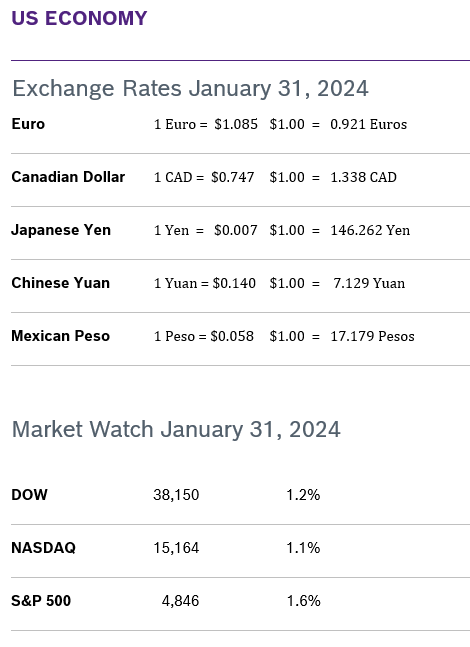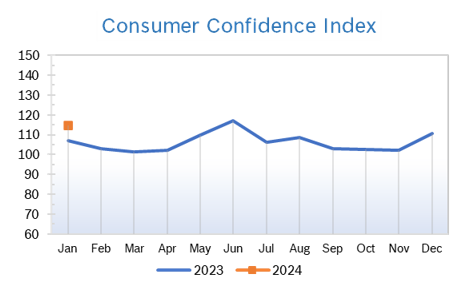|
Stocks tumbled the last day of the month as chances of a rate cut in March faded, but all three markets still posted modest gains for the month. Analysts attributed a mild pullback on the last trading day of the year to rebalancing portfolios, and most see interest rate cuts ahead, perhaps as soon as mid-year. Consumer Spending Falls 0.2% Consumer spending fell 0.2% in December and November spending was revised to a 0.1% decline from a 0.1% gain. Spending on services rose 0.5%, matching November’s gain. Spending on long-lasting manufactured goods like motor vehicles, recreational goods and household furniture and equipment decreased 1.9% after plunging 3.0% in November. Spending on nondurables like clothing and footwear declined 1.4% in December. The relatively weak showing in consumer spending and slowing price increases will allow the Fed to consider cutting interest rates next year. Consumer Prices Rise 0.3% The Consumer Price Index (CPI) rose 0.4% in December after holding steady for the previous two months and was up 3.1% year over year after being up 3.4% year over the year for the previous two months. Core prices were up 0.3% for the second consecutive month. The core CPI inflation rate peaked at a 40-year-high of 6.6% in September 2022. The personal consumption expenditures (PCE) price index edged up 0.1% in December after rising by the same margin in November. In the 12 months through December, the PCE price index increased 5.0%. That was the smallest year-on-year gain since September 2021 and followed a 5.5% advance in November. Inflation peaked at 9.1% in June 2022. Consumer Confidence Rises to 114.8
Unemployment Steady at 3.7%
Chicago PMI Falls to 46 The Chicago PMI fell to 46 in January after falling nearly ten points to 46.9 in December. Economists had expected the PMI to inch up to 48. Looking back to when the series began in 1967, the PMI has ranged from 20.7 in June 1980 to 81.0 in November 1973. Wholesale Prices Fall 0.1% The Producer Price Index (PPI) fell 0.1% in December after falling a revised 0.1% in November and was up 1.0% year over year. Stripping out volatile food and energy prices, core PPI rose 0.2% in December after rising 0.1% in November and was up 2.5% year over year for the second consecutive month. The PPI peaked at a whopping 11.7% year-over-year increase in March 2022. Q4 GDP Grows 3.3% Fourth quarter GDP grew 3.3%, well ahead of expectations of 2.0% growth. GDP growth was balanced, with real consumer spending growing 2.8%. Real GDP grew 3.1% between fourth quarter 2022 and fourth quarter 2023 despite 525 bps of Fed rate hikes since March 2022. For the full year, GDP grew 2.5%, ahead of estimates of 2.4% growth and well ahead of 1.9% growth in 2022. The core PCE deflator, which Fed officials view as the best measure of the underlying pace of consumer price inflation, rose at an annualized rate of just 2.0% in Q4, the second consecutive quarter in which prices have risen at the FOMC's target of 2%. The favorable news on inflation gives the FOMC leeway to begin an easing cycle; analysts disagree as to whether the first 0.25% rate cut will come in March or May but are now hopeful the Fed will begin to cut rates before mid-year. Fed Holds Rates Steady The Federal Reserve held rates steady at between 5% and 5.25% in January for the fourth consecutive time, as widely expected. Markets were disappointed that there was little indication the Fed was considering cutting rates at their next meeting in March, and now expect the first cut to come at the meeting May 1. The Fed did remove the language that stated they had an implicit bias to tighten further as needed. The move signals that the Fed believes inflation is under control and borrowing costs are now high enough to keep it that way. Estimates show Fed watchers now expect total rate cuts of 1.25% by the end of the year. Rates currently remain at the highest level in 22 years. © Robert Bosch Tool Corporation. All rights reserved, no copying or reproducing is permitted without prior written approval.
Comments are closed.
|
|










